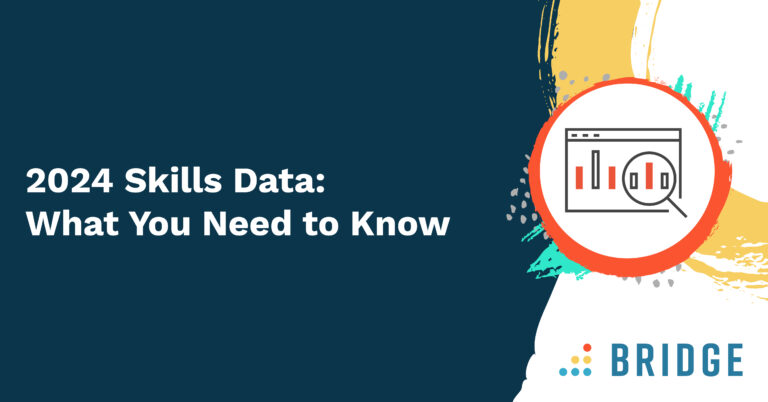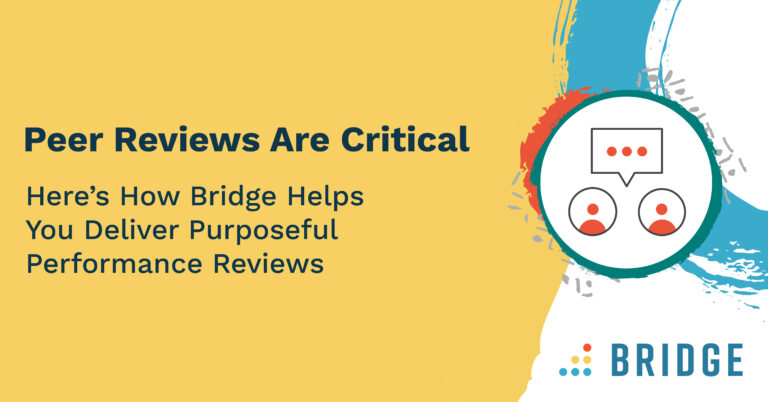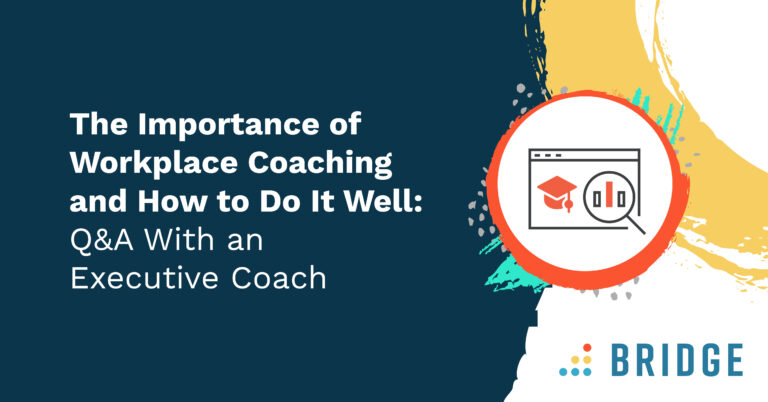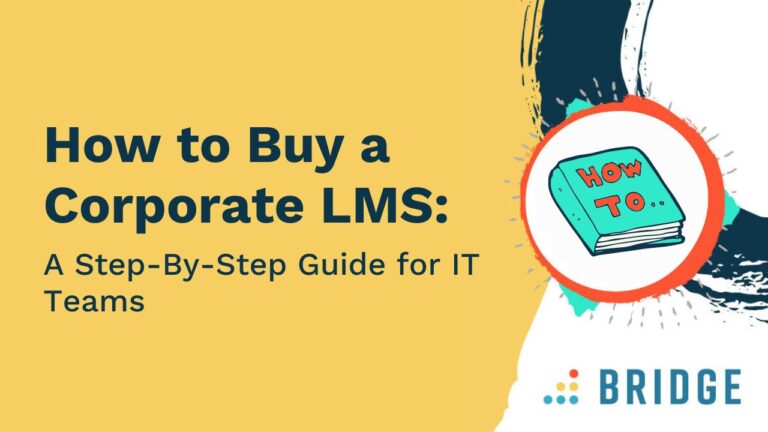The case for employee upskilling and reskilling is clear. In the Bridge-sponsored Future of Upskilling and Employee Learning 2024 report, 95% of HR professionals anticipate a disruption to jobs and roles due to market and technological shifts.
As a result, 77% expect developing employee skills to be a priority in the near future.
A skills-based strategy that closes current gaps, anticipates future demands, and delivers training to your people in ways that resonate is one that will keep your organization and your people competitive.
The Changes Shaping Workplace Skills Development
Equipping your people with the skills they need for the future requires an agile approach to training and development that anticipates (and shifts with) demand. Here’s what those demands look like.
1) Digital Transformations Are Redefining Existing Roles
Unsurprisingly, AI is changing the skills required for many and accelerating the pace of transformation. In fact, LinkedIn's Future of Work Report estimates that 84% of US employees are in jobs that could leverage generative AI to automate at least a quarter of their tasks.
As tech becomes more capable of performing tasks that only humans could previously do, the jobs and roles your people perform are likely to change. For example, while the research predicts AI will automate tasks like reporting and time management, it can't replace creativity, perform manual tasks, or build relationships.
As only 4% of business leaders expect to make any substantial changes to their workforce, identifying the tasks that can be automated by emerging technologies could lead to reshaping roles and training employees in other areas.
ADDITIONAL INSIGHTS | ‘The Promise and Panic of AI: How to Reframe Thinking About Artificial Intelligence’
2) Human Capabilities Are Needed to Embrace Adaptability
As explored in Deloitte's Human Capital Trends report, the rise in tech adoption by businesses and employees requires a different approach to skills development.
While the goal was once to deploy easy-to-teach technical development programs for specialized roles, over 70% of executives consider human capabilities and behaviors essential for employees to make decisions and build relationships.
A focus on these human behaviors means that HR professionals need a scalable approach to training and development across different roles and departments.
Furthermore, this training must be continuous and adaptive, allowing employees to meet current and future challenges.
Some of the skills identified as becoming more important include:
- Agile thinking
- Social and emotional intelligence
- Curiosity and imagination
- Collaboration
- Resilience
3) High-Value Leadership Skills Are Now Critical
Organizations consider working with others critical for the future, and according to the World Economic Forum's Future of Jobs report, over 40% are investing in developing leadership, empathy, and mentoring competencies.
Employees rely on managers and leaders for direction and certainty, but further evidence in the Future of Upskilling and Employee Learning report shows that only a small percentage of HR professionals rate managers' capabilities highly.
It's their job to go beyond overseeing and play a role in actively developing employees, making decisions, and building trust. Doing so demands a set of strong interpersonal and relationship-building skills and a culture that fosters connection.
Since becoming a great leader can't be taught through formal learning alone, it’s important that you identify employees with managerial potential before they step into senior roles and give them plenty of time to practice and develop their skills.
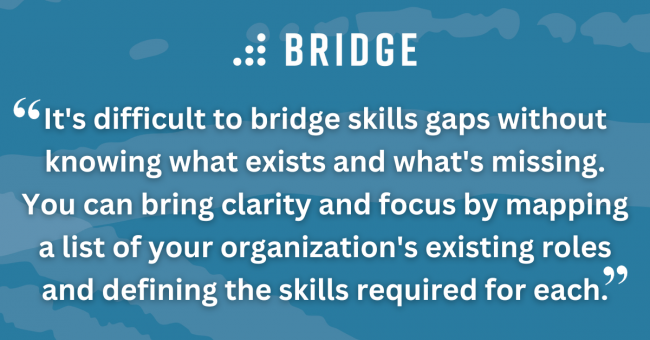
3 Key Components of a Skills Development Strategy
Here are three ways to build workforce capabilities and prepare your people for ongoing success.
1) Construct a Skills Framework
A skills framework maps skills to business needs and employee capabilities so you can quickly deploy high-impact strategies that meet key demands.
Identify Current and Future Skills Needs
It’s difficult to bridge skills gaps without knowing what exists and what’s missing. You can bring clarity and focus by mapping a list of your organization’s existing roles and defining the skills required for each.
You’ll want to be sure you’re aligned with current and upcoming business priorities, as this will impact where you focus your efforts. To ensure strategic alignment, reference these skills against performance goals and business objectives.
LEARN MORE | ‘Skills Mapping 101: How to Visualize Employee Capabilities’
Evaluate Skills Proficiencies
Assessing employee skills and proficiency levels can help you identify top performers and target training and development efforts.
The following types of data can assist you in this exercise:
- External labor market data, including declining and growing skills, industry trends and demands, and market conditions
- Internal HR and employee data, including learning and development information, skills assessments, feedback, and performance goals
An AI-powered learning and development platform brings structure to your upskilling programs by connecting up-to-date job market information with employee data. By comparing this information, you’ll quickly see trending skills for job roles and whether your people are developing in the right areas.
Once you visualize skills and compare gaps to industry demands, you can plan to fill these gaps.
2) Personalize Employee Skills Development
Effective skills development programs should close immediate gaps and address upcoming needs. Once you know what skills your people need, create engaging learning experiences that align personal and professional goals.
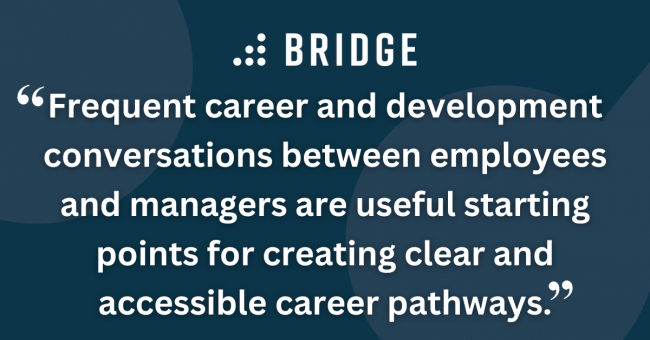
Help Employees Understand Their Skills
According to LinkedIn’s Workplace Learning Report, people are four times more likely to engage in learning when they set career goals when compared to those who don’t.
You need to ensure that your skills development efforts prepare employees to develop and advance within your organization. Creating a skills development plan is an effective way to uncover employees’ goals and keep that learning aligned with business goals.
Frequent career and development conversations between employees and managers are useful starting points for creating clear and accessible career pathways that steer them toward future success.
Together, these conversations allow them to map out training goals, assign tasks, and find helpful content from your library. This gives a sense of ownership and purpose to skills development, keeping your people on track and helping them to take action with skills feedback and check-ins.
KEEP READING | ‘4 Steps to Creating an Employee Skills Development Plan’
Recommend Relevant Content
With a development plan based on an employee’s career vision, you give your people the power to own their development. Providing the right content at the optimal moments can make this even easier.
When your skills data is integrated into your learning platform, you can tag your content with the right skills. This provides employees with relevant content and learning pathways to reinforce concepts with hands-on practice.
Along with your content, this level of personalization informs your employees’ development by allowing them to explore job opportunities related to their skills, and gain experience through projects and tasks.
Encourage Community-Based Learning
A learning and development platform can facilitate connection between your people, increasing knowledge-sharing behaviors while improving all-important people skills.
Identify people with shared skills development goals and those willing to assist others in their development journeys. By fostering learning communities and one-on-one mentorship programs, you make learning a collaborative and shared experience.
Tracking metrics such as feedback, skills assessments, and group-based learning outcomes with LMS reporting and analytics will allow you to see improvements over time.
READ MORE | ‘Mentoring 101: Planning the Perfect Mentorship Program’
3) Use Skills Data to Make Decisions About the Workforce
An interconnected learning, development, and skills platform is the driving force behind your workforce capabilities. When your skills data exists within a single integrated HR platform, it provides greater transparency and informs in-the-moment decisions.
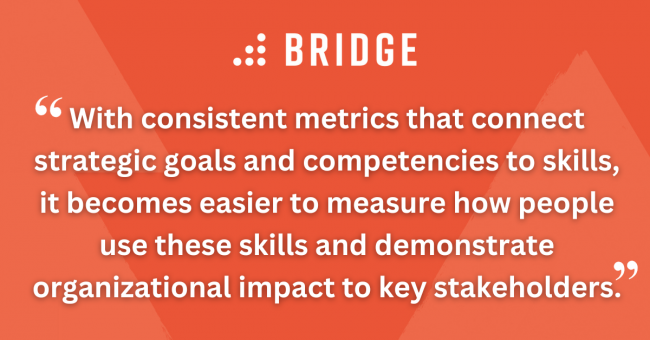
Standardize Skills Measurement With Performance Goals
A future-proof skills framework should be aligned with business strategy and filtered to the individual level. This way, skills development goals are closely linked to strategic organizational priorities, showing your people the part they play in success.
With consistent metrics that connect goals and competencies to skills, it becomes easier to measure how people use these skills and demonstrate organizational impact to key stakeholders.
Implementing skills data into the performance management process allows for a standardized evaluation of skills and a way to measure and track development, enabling you to:
- Identify high-impact skills that drive business performance
- Personalize the performance review process to strengthen employee capabilities
- Continuously monitor progress
FIND OUT HOW TO FOSTER A CULTURE OF GROWTH | ‘How to Create a Performance Management Plan’
Optimize Succession Planning Efforts for High-Value Skills
A skills-based approach to the workforce helps identify high-value competencies and roles. Using this insight, you can check that existing talent has the capabilities to perform these critical tasks.
You can also minimize future disruption by identifying the right talent for the right roles and preparing them to move into these roles in the future.
Empower Your Managers
Your managers are integral in communicating a purpose and vision to your people and influencing their development and growth. To maximize their effectiveness in this role, ensure they’re not losing time to repetitive tasks and that they’re able to focus on the people-based aspects of their roles.
A single learning platform can create efficiencies for managers and help them develop their skills by providing conversation prompts, tracking agendas, scheduling reminders, and keeping check-ins frequent.
Providing them with employee skills data can inform their conversations and allow them to strategically assign training and development based on individual needs at a given moment. In addition, they should have consistent visibility over their teams’ performance and skill levels.
MORE WAYS TO PARTNER WITH PEOPLE MANAGERS | ‘How HR Can Help Managers With Talent Development’
Upskill With Ease Using Bridge’s LMS
You only need a single platform to bring your talent strategy to life. With Bridge, you can dynamically match skills, create a complete picture of existing capabilities at a given moment, and respond to any emerging skills development needs.
